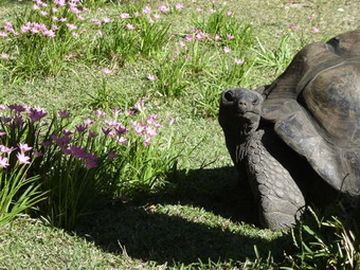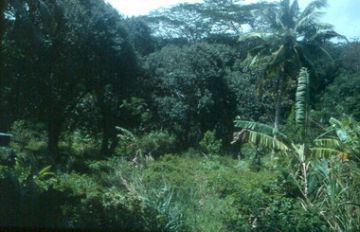Justin Gerlach
University Museum of Zoology Cambridge, Downing Street, Cambridge CB2 3EJ, UK
Based on a presentation to the BCG Symposium at the Open University, Milton Keynes on the 19th March 2005
Historically the granitic islands of the Seychelles group were occupied by a variety of indigenous and endemic vertebrate species. Most of the lizards and amphibians remain widely distributed and abundant but populations of Chelonia and birds have declined significantly over the last 200 years, with many populations becoming extinct. Chelonian species naturally included breeding populations of the Critically Endangered hawksbill (Eretmochelys imbricata) and green turtles (Chelonia mydas), the terrapins Pelusios seychellensis (probably extinct), P. subniger parietalis (Critically Endangered) and P. castanoides intergularis (Critically Endangered), and two species of giant tortoise (the Seychelles giant Dipsochelys hololissa and Arnold’s tortoise D. arnoldi). The giant tortoises were thought to be extinct from about 1840 but were rediscovered in 1996 and bred in captivity in 2002.
The Dipsochelys giant tortoises of Seychelles are known to have been widely distributed in the granitic islands and Aldabra atoll, although their presence in the coraline Amirantes is not certain. The taxonomy of these tortoises has been highly contentious in the past, with eight taxa being described as species (excluding the extinct species from Madagascar). The most recent review (Gerlach & Canning, 1998) recognised four of these taxa as species, considering the other four to be synonyms of the Aldabra tortoise Dipsochelys dussumieri (also, but incorrectly, known as D. elephantina, Geochelone gigantea, Aldabrachelys gigantea or A. elephantina). Of the four recognised species, three survive to the present day: D. dussumieri, D. arnoldi and D. hololissa (Fig.1).
It has been suggested that the ancestral Seychelles-Aldabra giant tortoise colonised the granitic islands within the last million years from Madagascar (Gerlach, 2004). This diverged into two morphotypes: the inland, browsing D. arnoldi and the coastal, grazing D. hololissa. Reduced sea-levels 100,000 years ago enabled coastal tortoises (D. hololissa; Fig. 1) to colonise the southern atolls, with subsequent sea-level rise eliminating the intervening populations on the Amirantes. The population on Aldabra became morphologically distinctive and has diverged genetically only very slightly since then, remaining genetically very similar to D. hololissa.
Conservation requirements of Seychelles Chelonia
The Seychelles government is currently active in furthering the protection of the marine turtles. An important component of this is protection of nesting areas on the reserve islands (Bird, Aride, Cousin and Cousine), marine parks (St. Anne, Silhouette and Curieuse) and conservation managed islands (Denis, North and Fregate) (Fig. 2). Future conservation requires the continuation of existing measures.
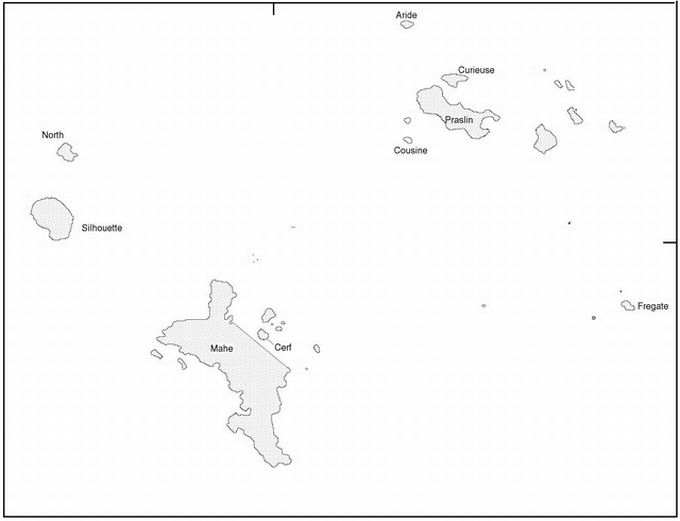
Figure 2. Map of the granitic islands of Seychelles; the coral islands of Bird and Denis are 50km to the north.
Terrapin conservation requirements were described in the Seychelles Terrapin Conservation Action Plan (Gerlach 2002). Of the two surviving species Pelusios castanoides currently has no secure populations other than a small population on Cerf island. Reintroduction can be carried out to two sites where the causes of historical population extinction (human consumption) no longer operate (Grande Barbe and La Passe on Silhouette). Pelusios subniger has secure populations on Cerf, Fregate and Praslin. Reintroduction is ongoing on Silhouette (Grande Barbe) and additional populations should be established on that island at La Passe and Anse Patates. Reintroductions should also take place on North and Aride islands. This would result in 8 viable populations on 6 islands.
The Aldabra tortoise is well protected on Aldabra (100,000 individuals) with viable introduced populations on the islands of Curieuse (100) and Fregate (180). The Seychelles tortoises are reduced to four wild male D. hololissa (one on Cerf and 3 on Cousine) and a single wild female D. arnoldi (Cousine). The conservation management of Cousine means that this locality could play a role in re-establishing wild Seychelles tortoises, there is little prospect for such management on Cerf. Other surviving individuals are kept in captivity, mostly in the NPTS captive breeding programme.
Captive breeding of Seychelles giant tortoises
The captive breeding programme for the Seychelles giant tortoises comprises almost all the known survivors of the two species: 2 female and 4 male D. hololissa, and 3 female and 3 male D. arnoldi. A small number of males of both species have been located elsewhere but only the single female D. arnoldi on Cousine island. The first eggs in the breeding programme were laid in 1999 but provide to be infertile, further infertile eggs were produced until 2002 when successful hatching occurred. To date fertile eggs have hatched from three females: one D. hololissa ('Josephine') and two D. arnoldi ('Betty' and 'Alida'). Josephine is a young tortoise (19) and her eggs are relatively small and thin shelled; fertility is low (11-50%) and hatching success is also low (63%) due to thin egg shells being prone to dehydration. So far only five D. hololissa have hatched; it is anticipated that success rates will improve as Josephine matures. Betty has produced only one clutch of fertile eggs with a 43% fertility rate. She did not lay any fertile eggs in 2004. The vast majority of hatchlings produced were from Alida (92%). In 2003 these were the produce of a mating with a D. hololissa ('Christopher'), resulting in 45 hybrids. Alida’s rate of egg laying is phenomenal, as is her fertility rate (75-92% in 2003). In 2004 the two species were separated during the mating season and Alida mated with the D. arnoldi 'Hector', producing 44 hatchlings. The last hatchling of this group appeared in March 2005, over a year after the last mating with Hector, by which time fertility had fallen to 10% (although it had remained constant at 82-91% throughout 2004).
The hatchlings of the Seychelles and Aldabra giant tortoises are all clearly distinctive at hatching with Aldabran D. dussumieri being black, D. hololissa being dark grey and D. arnoldi being brown with paler centres to each scute, hybrids between D. arnoldi and D. hololissa are variable in shade between the typical parental colours (Gerlach & Bour 2003). Within a few weeks all darken to black but the shape of the juveniles is also distinctive; D. dussumieri is always an even domed shape whilst D. hololissa has a depressed carapace. With D. arnoldi we have observed two distinct forms: the offspring of Betty and Hector have been dome shaped but with the distinctive scute patterns of D. arnoldi whilst Alida and Hector’s offspring are remarkably flattened (Fig. 3). These flattened hatchlings also have an unusually compulsive climbing behaviour, these two features result in baby tortoises that keep falling over onto their backs and constantly need rescuing as they are unable to right themselves. Fortunately this problem seems to resolve itself after about one month.
Restoration of the chelonian fauna of Silhouette island
The availability of captive bred juveniles makes reintroduction feasible in the near future. In order to conserve as much genetic diversity and evolutionary potential as possible several different combinations of genotypes could be established in different areas. D. hololissa is believed to be naturally a lowland grazing species, suitable areas for this species include coastal areas of Silhouette. There is also suitable habitat on the small coastal plateau of Cousine island and the large flat area of North island. The slow rate of breeding of this species so far means that reintroduction will be a long-term proposal. D. arnoldi is a browsing species, historical records indicate that it was mainly found in upland forests. On Silhouette the high-altitude marshes of Belle Vue and Mare aux Cochons (Fig. 4) would be suitable reintroduction sites.
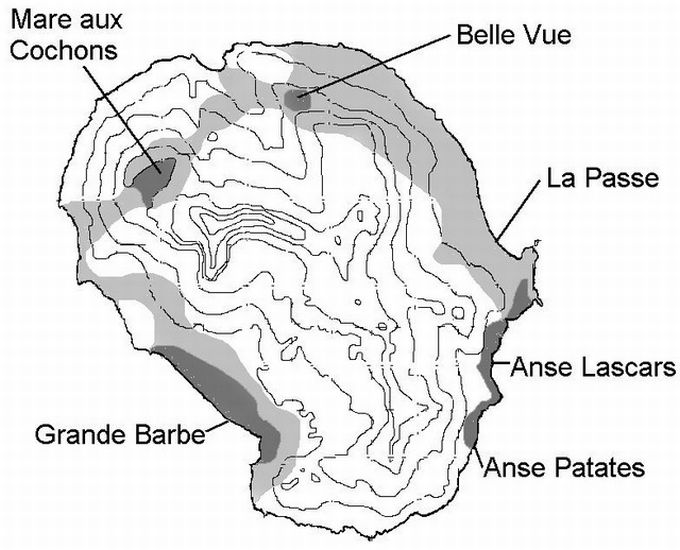
Figure 4. Proposed introduction sites on Silhouette island. Reintroduction sites shaded dark grey, other potentially suitable habitat shaded light grey.
Another possible reintroduction site is Aride island which has only a small area suitable for tortoises, this provides little open grazing and is best suited to the browsing D. arnoldi. An extensive area of suitable tortoise habitat exists at Grande Barbe on Silhouette. This is coastal plateau of mixed marsh and woodland that could be suitable for either species. The variation of the site would favour the genetically more varied hybrids and allow them to adapt to their own appropriate niches.
The Nature Protection Trust of Seychelles is planning to establish secure populations of the Seychelles tortoises, terrapins and turtles on Silhouette island, resulting in the re-establishment of the natural fauna and flora of selected sites, providing improved habitat for globally threatened species and improving the hydrology of fire-prone areas. Silhouette island is the third largest and second highest of the central granitic group of islands with a land area of 1,995 hectares and a maximum altitude of 750m. Due to its steep mountainous nature the island is one of the least suitable for development and has therefore retained much of its natural flora and fauna. Of all the granitic islands it has the highest level of biodiversity and warrants special care and protection. NPTS is responsible for conservation on the island.
Four main areas are suitable for tortoise reintroduction. Of these two, Belle Vue and Mare aux Cochons, are high altitude marshes (250 and 500m above sea level respectively) (Fig. 5). Both areas were extensively modified by small-scale agriculture in the 1900s but are now abandoned. The habitat is largely a mixture of alien plants (principally Clidemia hirta, Lanana camara and Panicum maximum and coffee plantation at Mare aux Cochons) although native trees are regenerating. Significant species present are the Critically Endangered Seychelles fineliner damselfly Teinobasis a. alluaudi, the endemic crab Seychellum alluaudi and an endemic trap-door spider Conothele truncicola. There are no historical records of Chelonia at either site although it is probable that tortoises would have been present until the mid-1800s. These could be re-established with little difficulty at Belle Vue but habitat restoration is needed at Mare aux Cochons.
The marsh at Grande Barbe is currently recognised as the largest surviving wetland in Seychelles free from all alien species (with the exception of the fish Oreochromis mossambicus). Historically it covered an area of about 20 hectares and would have been one of the largest marshes in Seychelles. In the early 1900s it was largely drained and is now restricted to only 6 hectares of permanent flooded marsh. Despite this great reduction in area the Grande Barbe marsh system includes all the main marsh habitats found in Seychelles with particularly important areas of enclosed mangrove and coastal woodland marsh. Grande Barbe is the second largest settlement on Silhouette and the extensive drainage during the years of agricultural development of the area has heavily modified most of the plateau. For the past 3 decades the settlement has been declining following the collapse of the copra industry, the mainstay of the Grande Barbe settlement. At present only 6 people remain. With no economically viable agriculture and a small human population there is a unique opportunity to restore this area to its natural state. Grande Barbe supports a high diversity of invertebrates, including the Critically Endangered Seychelles fineliner damselfly (Teniobasis a. alluaudi) and historically would have supported the Endangered Seychelles black paradise flycatcher (Terpsiphone corvina) and Seychelles sheath-tailed bat (Coleura seychellensis). All Seychelles chelonians probably bred in and around the marsh and beach at Grande Barbe. The plateau includes a significant area of grassland suitable for the giant tortoises and the marsh is good terrapin habitat. The beach is one of the largest nesting sites for hawksbill turtles left in the granitic Seychelles (70 confirmed and a total of 182 possible nests in 2004/5). In 2002 the first reintroduction of the terrapin P. subniger parietalis was carried out, with further releases occurring in 2003.
Anse Lascars supported a small human population until 1989 when the settlement was abandoned due to the lack of permanent fresh-water following a long-term change in water courses. The area represents coastal habitat with a mixture of native coastal forest, coconut plantations and abandoned ornamental plants. Small numbers of hawksbill and green turtles nest on the beaches which are used by small numbers of visitors to the island. Island residents use the reefs and shores for sustainable extraction of marine resources (gastropods, octopus and fish). Palm leaves are cut from the forest and cinnamon bark and coconuts extracted on an occasional basis.
Reintroduction of terrapins
Plans to reintroduce Pelusios terrapins in accordance with the Seychelles Terrapin Action Plan (2002) started in 2002 with the reintroduction of P. subniger to Grande Barbe. Successful captive breeding of P. castanoides in 2003 should make future reintroduction possible from 2006.
Reintroduction of tortoises
Poaching of marine resources and sea birds is a problem for many islands. However the planned reintroduction sites on Silhouette are expected to be safe from poaching due to difficult sea conditions at Grande Barbe meaning that this site is only accessible by boat for a short period of time; the high-altitude marshes are only accessible by 2-6 hour walks by steep mountain paths, and are not visited by casual visitors. The only easily accessible site is Anse Lascars and this once tortoises have been released in this area volunteers and researchers will be used to ensure a human presence in the area during the season when boats are able to land on the coast.
Introduced predators are present on Silhouette in the form of black rats and cats. Rats are very scarce (only one was caught at Grande Barbe in 350 trap nights in 2002); the number of cats at Grande Barbe is not known although they are seen regularly and tracks on the beach indicate the presence of at least 2 individuals on the plateau. Cats are very rarely seen inland. Tortoises coexist and breed with successful recruitment in the presence of cats and rats on Aldabra and Curieuse island. On Curieuse headstarting protects juvenile tortoises; released 5 years olds (30cm long) have a very high survival rate and there is no evidence of predation on this age group.
Prior to reintroduction habitat management is required at Mare aux Cochons. This can be achieved by filling in the channels which were established in the 1950s to drain the wetland. This will allow the wetland to re-establish its historical level, an important precursor to restoration of the wetland. Tree removal would then be much easier and the recovery of marsh vegetation from its existing refugia should be a largely natural process, facilitated by small-scale management.
The captive breeding project for the Seychelles giant tortoises aims to reintroduce tortoises to secure areas. The experience of headstarting Aldabra giant tortoises on Curieuse island demonstrates that release of 5 year old juveniles is practical with such tortoises being large enough to be safe from predation. The growth of the 2002 hatchlings suggests that they could be large enough for release as early as 2005-6 (Fig. 6).
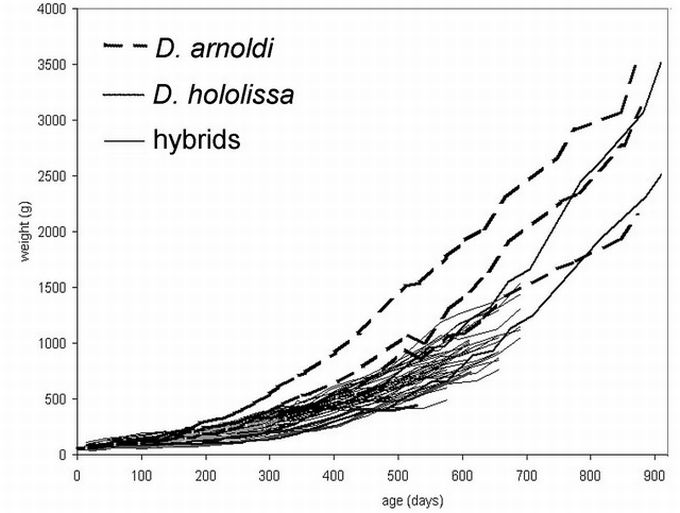
Figure 6. Growth rates of captive bred Seychelles tortoises.
It is proposed that the conservation areas of Belle Vue and Grande Barbe be enclosed by low tortoise-proof barriers. These can be constructed from logs of alien trees (principally coconuts and Tabebuia pallida). At Belle Vue an extensive barrier of some 500m would be required, whilst most of Grande Barbe is naturally isolated by cliffs and rivers, so only a relatively small section of secure barrier would be needed. Anse Lascars would be completely tortoise-proof with the addition of a gate across the single track. Within these areas smaller release pens should be enclosed to accommodate groups of at least 30 juvenile tortoises annually. These will be monitored regularly and released from the holding pens after 3 months. The enclosed conservation areas would contain the developing tortoise population and prevent dispersal at too early a stage. Habitat restoration will need to be initiated at Mare aux Cochons before enclosures can be constructed.
The conservation requirements of the Seychelles Chelonia can thus largely be met through reintroduction to: Silhouette (Grande Barbe marsh system, Anse Lascars, La Passe and Belle Vue), Fregate, Aride, North, Praslin (Lemuria) and Cousine. Reintroduction to the small islands (Aride, Cousine and North) and sites (terrapins on Praslin) will be organised in collaboration with the managing agencies and significant external funding will not be required.
| Table 1. Planned reintroductions |
|---|
| | Number |
| | species | location | timing | released | projected* |
| terrapins | Pelusios subniger | Silhouette | Grande Barbe | 2002-4 | 24 | 100 |
| La Passe | 2006 | 10 | 100 |
| North island | 2006 | 10 | 100 |
| TOTAL | 300 |
| P. castanoides | Silhouette | Grande Barbe | 2007 | 10 | 100 |
| North island | 2007 | 10 | 50 |
| TOTAL | 150 |
| tortoises | Dipsochelys hololissa | Silhouette | Anse Lascars | 2008 | 50 | 460 |
| North island | 2008 | 50 | 1,000 |
| Cousine island | 2008 | 10 | 50 |
| TOTAL | 110 | 1,510 |
| D. arnoldi | Silhouette | Belle Vue | 2006 | 20 | 50 |
| Mare aux Cochons | 2008 | 20 | 170 |
Aride island | 2007 | 10 | 20 |
| TOTAL | 50 | 240 |
| mixed | Silhouette | Grande Barbe | 2006 | 100 | 560 |
| TOTAL | 100 | 560 |
* for tortoises this is assuming population densities of 21.6/hectare in open habitat and 6.2/hectare in woodland, based on data for the Aldabra tortoise
References
Gerlach, J. 2004 Indian Ocean giant tortoises. Chimaira, Frankfurt.
Gerlach, J. & Bour, R. 2003 Morphology of hatchling Dipsochelys giant tortoises. Radiata 12; 11-20
Gerlach, J. & Canning, L. 1998 Taxonomy of Indian Ocean giant tortoises (Dipsochelys). Chel. Cons. & Biol. 3; 3-19
Testudo Volume Six Number Two 2005
Top

